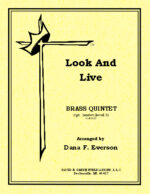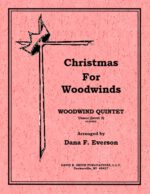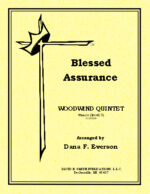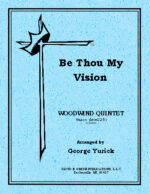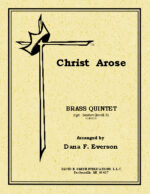| Instrument | |
|---|---|
| Level | 1 |
| Occasion | |
| Theme | God Is So Good |
| Writer | |
| Publisher | |
| Copyright | 1998 |

God Is So Good
$24.95
Related products
-
-
Look And Live
$12.00A traditional brass quintet with opt. trumpet for horn and extra baritone for use as a sextet. The introduction uses extraneous material where it leads in the first theme in the French horn, supplemented by trombone counterlines and trumpet flourishes. Thematic movies are then embellished leading up to a modulation where the tempo slows and a new mood encountered. The first trumpet carries the lead and offset with a horn duet line. Another modulation, an a-tempo with the theme in the low brass and accompaniment lines in the middle brass. This continues until the voices stack up until a boisterous conclusion is achieved.
-
Christmas for WW
$9.00(std+ opt)(opt quartet) Joy To The World; God Rest Ye Merry Gentlmn; Angels We Have Heard On High; O Little Town Of Bethlehem
-
Blessed Assurance
$9.00This woodwind quintet (with opt. parts) is constantly on the move. While the melodic material is always made aware, the accompanying parts are full of movement. Even with metrical changes there is a constant flow giving a sense confidence and resolve. It bubbles from beginning to end and finally makes a solid statement of assurance.
-
Guide Me, O Thou Great Jehovah
$9.00A woodwind quintet with opt. parts for Alto Sax and Bass Clar. This piece presents itself with a sense of joy throughout with the introduction itself in a motivic manner setting the tone. The melody is fragmented, passing the tune around to the various voices. The middle section mirrors the introduction in texture and again passes melodic material around the different voices. The final section is more subdued until it starts stacking the motifically structured parts until it ascends to a dramatic conclusion.
-
How Firm A Foundation
$12.00Opening with a fanfare, the first section is in block harmonization with some moving lines. It then moves into melodic statements in the lower instruments with supported obiligatti in the trumpets and horn. The structure again becomes solid in scoring only to return with similar trumpet obbligati. The obbligati is next introduced in the lower voices and then increased rhythmic activity in all voices builds to a solid ending.
-
-
Christ Arose
$12.00Scored for traditional brass quintet, an optional bartione part can be used to expand the piece to a sextet. After an opening upper brass fanfare, the lower parts present the theme in solemn fashion with further extended fanfares from the upper lines. The middle section reverses the stylistic assignments only to be given back to the opening styles. The with a powerful stacking of parts the piece concludes in a triumphant chord.


